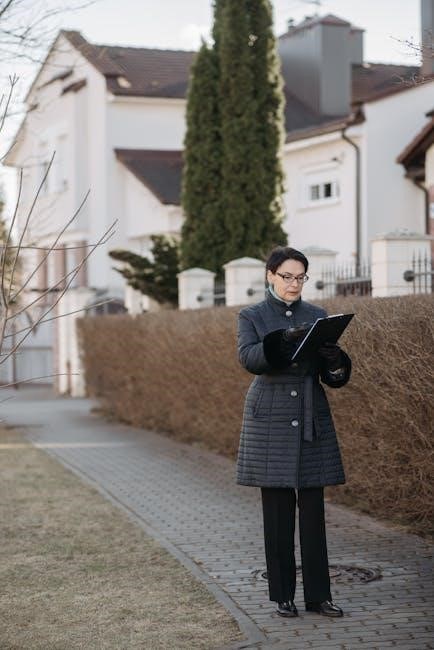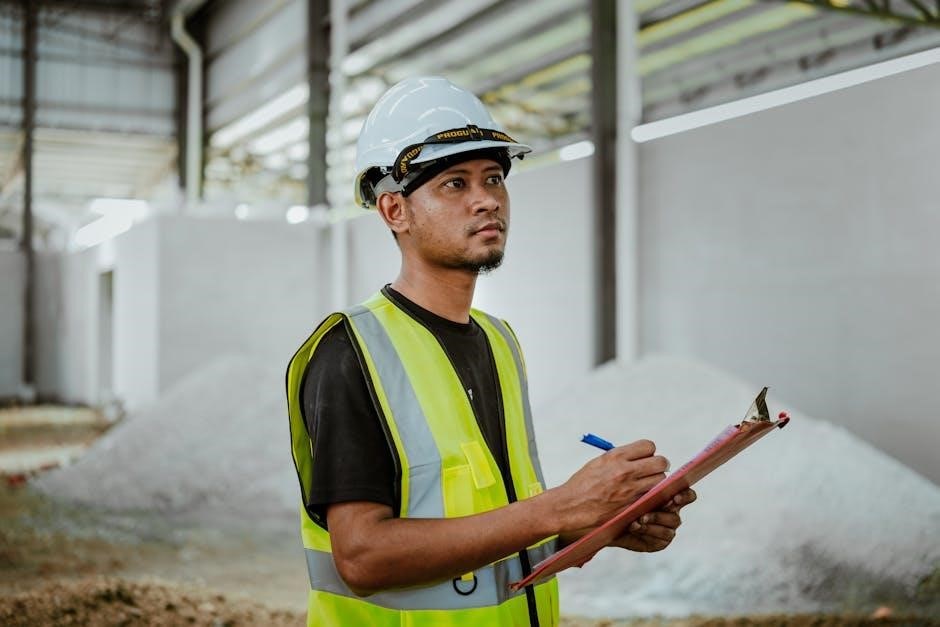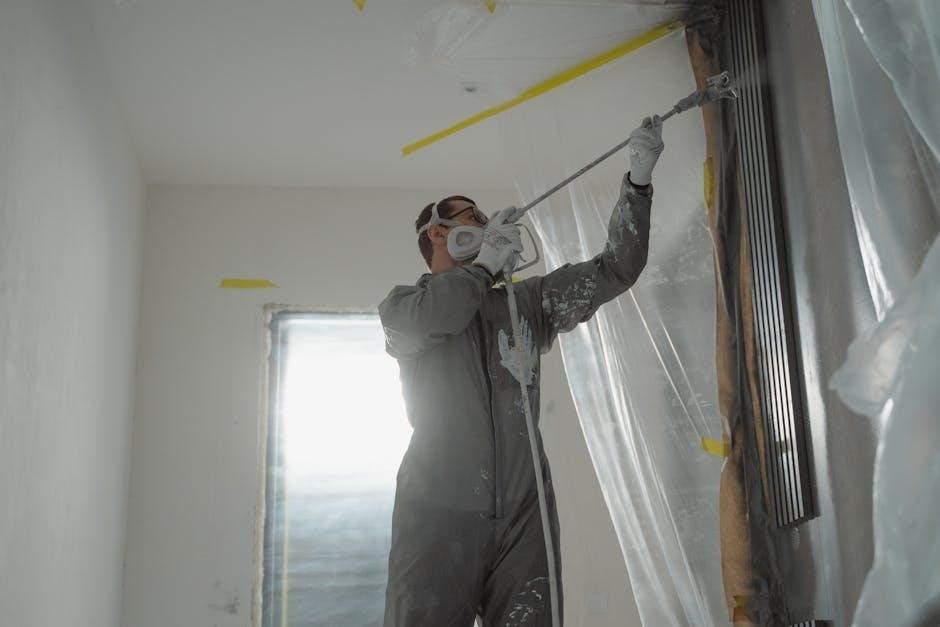A pre-drywall inspection checklist ensures all critical systems, like electrical, plumbing, and HVAC, are verified before drywall installation, preventing hidden issues and costly future repairs.
Importance of Early Detection
Early detection during a pre-drywall inspection is critical for identifying potential issues in framing, plumbing, and electrical systems. Catching problems early prevents costly repairs, ensures safety, and avoids delays. It also guarantees compliance with building codes, providing peace of mind for homeowners and contractors alike.
Savings in Time and Cost
Addressing issues early during a pre-drywall inspection saves time and money by preventing costly repairs later. Identifying and fixing problems before drywall installation avoids delays and reduces the need for major renovations. It also ensures compliance with codes, avoiding potential fines and ensuring a smooth project completion for contractors and homeowners.
Ensuring Compliance and Safety
A pre-drywall inspection ensures all systems meet local building codes and safety standards. It verifies electrical, plumbing, and HVAC installations are up to code, reducing risks of hazards. Proper safety devices and installations are confirmed, ensuring a safe living environment and avoiding potential legal or liability issues for contractors and homeowners.
The Pre Drywall Inspection Checklist
A pre-drywall inspection checklist is a comprehensive tool for contractors and inspectors. It ensures all systems are reviewed before drywall installation, meeting industry standards and preventing future issues.
Essential Items to Include
A pre-drywall inspection checklist should include structural integrity checks, electrical and plumbing system verification, HVAC components, insulation R-value confirmation, and documentation of potential issues. Ensure all critical areas are thoroughly reviewed to meet industry standards and prevent costly future repairs.
Foundation and Structural Checks
Inspect the foundation for cracks, unevenness, or signs of shifting. Verify structural framing is properly aligned, spaced, and secured. Check for any damage or gaps in load-bearing elements, ensuring the structure is level and stable before proceeding with drywall installation.
Electrical and Plumbing Verification
Verify electrical wiring is properly installed, outlets are correctly placed, and the electrical panel complies with codes. Check plumbing pipes for correct sizing, leaks, and proper connections. Ensure all fixtures and safety devices are functional. This step ensures compliance with industry standards and prevents future electrical or plumbing issues.
Insulation and HVAC Components
Ensure insulation meets specified R-values for energy efficiency. Verify HVAC components, including ductwork and ventilation, are properly installed and functional. This step prevents future issues and ensures compliance with building codes before drywall installation begins.

Framing Inspection
Verify structural integrity by checking framing alignment, spacing, and connections. Ensure all components are securely fastened to support the building’s weight and maintain stability before drywall installation begins.
Structural Integrity Check
Ensure framing components are properly sized, spaced, and aligned to support the building’s weight. Verify all connections and fasteners are secure, with no signs of damage or weakness, ensuring compliance with local building codes and standards for structural safety and durability.
Proper Alignment and Installation
Verify that all walls, floors, and ceilings are correctly aligned and installed. Check for proper placement of studs, joists, and rafters, ensuring they are plumb, level, and securely fastened. Confirm that all structural components are correctly positioned and comply with the approved plans and local building codes.
Secure Fasteners and Connections
Inspect all fasteners and connections to ensure they are properly secured and tightened. Verify that nails, screws, bolts, and brackets are correctly installed and meet specifications. Check for any loose or missing fasteners, and confirm that all connections are tight and properly aligned to ensure structural integrity and prevent future issues.
Plumbing System Review
A pre-drywall plumbing review verifies proper pipe installation and sizing, ensures leak-free connections, and checks water heater condition and drain pan installations.
Pipe Installation and Sizing
Verify pipes are correctly sized, properly secured, and made of approved materials. Ensure compliance with local codes and confirm sizing matches the building’s water demand. Check for correct routing and connections to prevent future leaks or water damage issues.
Leak Detection and Prevention
Inspect all pipe connections, fittings, and valves for signs of damage or improper sealing. Use pressure testing to identify potential leaks early. Ensure water shut-offs are installed and functioning correctly to prevent water damage and costly repairs during or after construction.
Safety Devices and Fixtures
Ensure smoke detectors, carbon monoxide alarms, and emergency lighting are properly installed and functional. Verify GFCI outlets are present in wet areas like kitchens and bathrooms. Check for proper installation of safety fixtures, including grab bars and anti-scald devices, to meet safety standards and prevent potential hazards.

Electrical System Evaluation
Evaluate electrical wiring, outlets, and panels for proper installation and code compliance. Ensure all circuits are labeled and grounded, and verify GFCI protection in wet areas to prevent hazards.
Wiring and Outlet Placement
Verify wiring is properly installed, securely fastened, and meets code requirements. Ensure outlets are correctly placed in every room, with GFCI protection in wet areas. Check for adequate circuit distribution and avoid overloaded systems to prevent safety hazards and ensure functionality.
Electrical Panel Inspection
Examine the electrical panel for proper installation, ensuring all components are secure and labeled correctly. Verify circuit distribution meets load requirements and complies with safety codes. Check for signs of damage or wear, ensuring the panel is up to code to prevent future electrical issues.
Compliance with Codes
Ensure compliance with local building codes during pre-drywall inspection. Verify electrical, plumbing, and HVAC installations meet required standards. Check for proper permits and adherence to safety regulations. Non-compliance can lead to future issues or legal consequences. Proper documentation ensures adherence, simplifying future inspections and maintaining accountability.
HVAC and Insulation Assessment
Verify proper HVAC installation, ductwork, and ventilation. Check insulation R-values and ensure correct placement. Assess system functionality and seal any leaks. Proper installation ensures energy efficiency and safety, meeting building codes and standards.
Ductwork and Ventilation
Ensure ductwork is properly sealed and insulated. Check for leaks, proper installation, and alignment. Verify ventilation systems provide adequate airflow. Inspect vents and registers for correct placement. Ensure compliance with local building codes to maintain efficiency and prevent future issues.
Insulation R-Value Verification
Confirm insulation meets required R-values for walls, ceilings, and floors. Verify proper installation without gaps or compression. Ensure compliance with local building codes and energy efficiency standards. Check foundation and above-grade wall cavity insulation for correct R-values and proper placement to ensure energy efficiency and structural integrity.
System Functionality Check
Ensure HVAC systems operate correctly, with proper airflow and ductwork connections. Verify ventilation systems function as intended, providing adequate circulation. Check that all components, including thermostats and controls, are installed and functioning properly. Confirm that insulation and HVAC systems meet energy efficiency standards before drywall installation begins.

Potential Issues Identification
Identifying potential issues like pest infestation, asbestos, fire hazards, structural damage, and electrical or plumbing malfunctions during pre-drywall inspection prevents costly repairs and ensures a safer living environment.
Pest Infestation Signs
Droppings, gnaw marks, burrows, or nests indicate pest activity. Check for damage to wooden studs, insulation, or wiring. Look for signs of termites, rodents, or carpenter ants in accessible areas before drywall installation to prevent future structural or health issues.
Asbestos and Hazardous Materials
Inspect for asbestos in insulation, pipes, or flooring, especially in older homes. Check for hazardous materials like lead paint or mold. Ensure compliance with safety standards and consider professional testing if suspect materials are found to avoid health risks and legal issues during construction.
Fire Hazards and Prevention
Verify fire-blocking materials are properly installed around penetrations and joints. Ensure electrical components meet safety codes to prevent ignition risks. Check HVAC venting for proper installation to avoid combustion hazards. Confirm fire suppression systems are installed and functional, adhering to local building codes and safety standards.

Documentation and Reporting
Comprehensive inspection reports and detailed checklists ensure accountability. Proper documentation captures all findings, providing a clear record for future reference and ensuring transparency in the process.
Effective Documentation Practices
Use detailed checklists and reports to record findings accurately. Ensure clarity and organization for easy reference. Include photos and notes to document issues. Maintain thorough records for accountability and future repairs. Proper documentation ensures transparency and serves as a reliable reference for all stakeholders involved in the project.
Comprehensive Inspection Reports
A comprehensive inspection report details findings from the pre-drywall checklist, ensuring all systems are reviewed. It identifies issues, verifies compliance, and provides actionable recommendations. Reports should be clear, well-organized, and include photos or notes for clarity. This documentation serves as a critical reference for contractors, builders, and homeowners, ensuring accountability and transparency throughout the construction process.
Accountability and Transparency
Detailed reports and thorough documentation ensure accountability, providing a clear record of inspections. Transparency is maintained by sharing findings openly with stakeholders, fostering trust and collaboration. This process ensures all issues are addressed promptly, avoiding disputes and ensuring compliance with standards and regulations throughout the construction process.

Best Practices for Inspection
Use a comprehensive pre-drywall inspection checklist to ensure accuracy. Engage qualified professionals for thorough evaluations. Utilize specialized tools for detailed checks. Maintain clear documentation for accountability and transparency.
Using Specialized Tools and Technology
Employ thermal imaging cameras to detect moisture issues and insulation gaps. Use laser levels for alignment checks and moisture meters for detecting water damage. Leverage inspection software for digital checklists and real-time reporting, enhancing accuracy and streamlining the documentation process for pre-drywall inspections.
Engaging Qualified Inspectors
Hiring licensed and experienced inspectors ensures a thorough evaluation of systems like electrical, plumbing, and HVAC. Their expertise in identifying potential issues aligns with checklist requirements, guaranteeing compliance and safety standards are met before drywall installation begins.
Ensuring Accessibility and Safety
Ensuring accessibility and safety involves clear pathways, proper lighting, and secure access points for inspectors. Verify emergency exits, sturdy scaffolding, and protective gear usage. This ensures a safe environment for thorough inspections, preventing accidents and allowing inspectors to focus on identifying potential issues effectively.
Frequently Asked Questions
Addressing common inquiries about the pre-drywall inspection checklist, such as its purpose, key areas of focus, and the benefits of early issue detection to ensure compliance and safety.
Common Inquiries and Clarifications
Common questions about pre-drywall inspections include understanding their purpose, key areas checked, and benefits. The checklist ensures electrical, plumbing, and HVAC systems are verified, preventing future issues. It’s a vital step for contractors and homeowners to address potential problems early, ensuring compliance and safety while avoiding costly repairs.
Addressing Inspector Qualifications
Ensuring inspectors are qualified is crucial for accurate pre-drywall evaluations. Look for certifications, experience, and familiarity with construction standards. A skilled inspector uses specialized tools and knowledge to identify potential issues, ensuring compliance and safety. Their expertise minimizes risks and guarantees a thorough assessment of all critical systems before drywall installation begins.
Understanding Inspection Frequency
Pre-drywall inspections are typically conducted once, before drywall installation, but frequency may vary based on project size and complexity. Regular checks ensure compliance with codes and standards, while excessive inspections can delay progress. Balancing thoroughness with efficiency is key to maintaining quality without causing unnecessary setbacks.

Common Mistakes to Avoid
Overlooking structural damage, improper wiring, and ignoring HVAC issues are common errors. Rushing inspections and missing potential hazards like pests or asbestos can lead to costly repairs.
Overlooking Critical Areas
Common oversights include neglecting foundation cracks, unevenness, or shifts, and ignoring electrical wiring issues or improper insulation R-values. Failing to check for pest infestation signs, asbestos, or fire hazards can lead to severe structural and safety risks if left undetected before drywall installation begins.
Neglecting Proper Documentation
Neglecting proper documentation during pre-drywall inspections can lead to legal disputes, costly rework, and compliance issues; Poorly recorded findings may omit critical details, such as missing insulation R-values or electrical wiring defects, causing future repairs and safety risks to go unnoticed until significant damage occurs.
Skipping Essential Checks
Skipping essential checks during pre-drywall inspections can result in hidden structural weaknesses, electrical wiring issues, or insulation defects. Overlooking critical areas like HVAC functionality or plumbing connections may lead to costly repairs and safety hazards after drywall installation, emphasizing the importance of thorough evaluations at this stage.




About the author